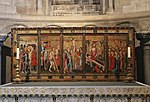Norwich School (formally King Edward VI Grammar School, Norwich) is a selective English independent day school in the close of Norwich Cathedral, Norwich. Among the oldest schools in the United Kingdom, it has a traceable history to 1096 as an episcopal grammar school established by Herbert de Losinga, first Bishop of Norwich. In the 16th century the school came under the control of the city of Norwich and moved to Blackfriars' Hall following a successful petition to Henry VIII. The school was refounded in 1547 in a royal charter granted by Edward VI and moved to its current site beside the cathedral in 1551. In the 19th century it became independent of the city and its classical curriculum was broadened in response to the declining demand for classical education following the Industrial Revolution.
Early statutes declared the school was to instruct 90 sons of Norwich citizens, though it has since grown to a total enrolment of approximately 1,020 pupils. For most of its history it was a boys' school, before becoming co-educational in the sixth form in 1994 and in every year group in 2010. The school is divided into the Senior School, which has around 850 pupils aged from 11 to 18 across eight houses, and the Lower School, which was established in 1946 and has around 250 pupils aged from 4 to 11. The school educates the choristers of the cathedral, with which the school has a close relationship and which is used for morning assemblies and events throughout the academic year. In league tables of British schools it is consistently ranked first in Norfolk and Suffolk and amongst the highest in the United Kingdom.
Former pupils are referred to as Old Norvicensians or ONs. The school has maintained a strong academic tradition and has educated a number of notable figures including Lord Nelson, Sir Edward Coke and 18 Fellows of the Royal Society among many others. Several members of the Norwich School of painters, the first provincial art movement in England, were educated at the school and the movement's founder, John Crome, also taught at the school. It is a founding member of the Headmasters' and Headmistresses' Conference (HMC), a member of the Choir Schools' Association and has a historical connection with the Worshipful Company of Dyers, one of the Livery Companies of the City of London.










